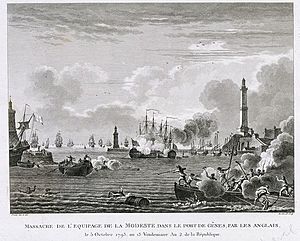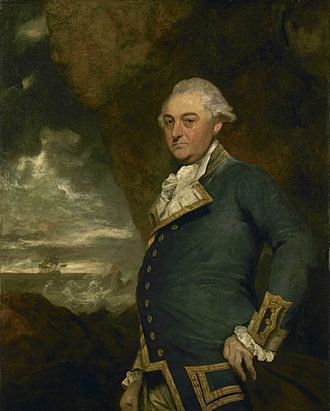Raid on Genoa facts for kids
Quick facts for kids Raid on Genoa |
|||||||
|---|---|---|---|---|---|---|---|
| Part of the French Revolutionary Wars | |||||||
 Massacre de l'equipage de la Modeste, Nicolas Ozanne |
|||||||
|
|||||||
| Belligerents | |||||||
| Commanders and leaders | |||||||
| Strength | |||||||
| 2 ships of the line 1 brig-sloop |
1 frigate 2 tartanes |
||||||
| Casualties and losses | |||||||
| None | 1 killed 10 wounded 1 frigate captured 2 tartanes captured |
||||||
The Raid on Genoa was a small naval battle. It happened in the harbor of Genoa, Italy, in 1793. This was during the first year of the French Revolutionary Wars.
French forces in the Mediterranean Sea were having a tough time. They were fighting armies from Austria and Spain. Also, people in France who supported the king were rebelling. The British Navy was also blocking their ports.
The French lost their main naval base at Toulon. British forces, led by Lord Hood, took over Toulon. This happened because people in Toulon who supported the king invited the British in. Some French ships escaped and hid in neutral Italian harbors. These included the frigates Modeste in Genoa and Impérieuse in Leghorn.
Lord Hood wanted to remove the threat these hidden French ships posed. He sent a group of ships, led by Rear-Admiral John Gell, to Genoa. They arrived on October 5, 1793. They found Modeste and two smaller warships anchored there.
Later that day, British ships sent out their smaller boats. They attacked the French ships, even though Genoa was supposed to be neutral. The French sailors fought back. But the British boarding parties captured all three ships. The British did not lose any sailors. Six days later, another British ship, HMS Captain, captured Impérieuse. This ship had fled to La Spezia.
This raid had important effects. The group in Genoa who supported France was strong. They stopped Austrian troops from sailing to help the British at the siege of Toulon. Without these extra troops, the defenders of Toulon were defeated. French forces attacked on December 17 and took the city.
Contents
Why the Raid Happened: The Mediterranean in 1793
The French Revolutionary Wars started in 1792. It was a fight between the new French Republic and the Austrian Empire. By 1793, other countries like Spain and Great Britain joined the war.
Inside France, there were also political problems. Many people rebelled against the Republic in the summer of 1793. One important place for these rebels was Toulon. This city was a major naval base for the French Mediterranean Fleet.
On August 28, Toulon surrendered to Lord Hood. He was the commander of the British Royal Navy's Mediterranean Fleet. Hood's forces took over the city and captured the French fleet there. He asked for more troops to defend Toulon. Spanish, Neapolitan, and Sardinian soldiers arrived as the siege of Toulon began.
Austrian troops were also promised. They were fighting the French in Northern Italy. These troops needed to travel by sea from Genoa. Genoa was the capital of the Republic of Genoa, which was officially neutral.
However, Genoa had its own political issues. The French Revolution inspired people in Italy to support similar ideas. There was a strong group in the Genoese government that supported France. Food supplies were often sent from Genoa to French armies. The British ambassador, Francis Drake, asked Genoa to stop this trade, but they did not listen.
French warships also made things difficult in Genoa. French ships that escaped Toulon had no home port. So, they hid in neutral Italian ports. They hoped Italy's neutrality would protect them from enemy fleets. Two large French ships were the 36-gun frigate Modeste and the 40-gun Impérieuse. They were hiding in Genoa and Leghorn.
These ships were a threat to Allied shipping. They also made it hard for troops to move through Italian ports. British ambassadors protested, but the French supporters in Genoa and Leghorn refused to make the French ships leave. In July, Modeste and another French ship, Badine, blocked a British frigate in the harbor. This was a clear insult. Because of this, Lord Hood decided the French frigates had to be removed. He wanted to force the French supporters in Genoa to stop helping France.
The British Attack on Genoa
Lord Hood sent a strong group of ships from Toulon to deal with the French frigates. Rear-Admiral John Gell led this force. He was on the 98-gun ship HMS St George. Other ships included the 74-gun HMS Bedford and HMS Captain. A French Royalist ship, Scipion, also joined them. Smaller warships like HMS Speedy were also part of the group.
Gell's orders were to sail to Genoa and capture Modeste. Hood wanted this operation to be a warning to those in Genoa who supported the French Republic. The British ships arrived outside Genoa on October 5.
Modeste was clearly visible in the harbor. It was anchored near two small sailing ships called tartanes. The British officers met to decide what to do. Since talking had not worked, they decided to use force. On the afternoon of October 5, Bedford slowly moved into the harbor. It pulled up next to Modeste. At the same time, boats from Captain moved close to the other side of the French frigate.
The French sailors reportedly made fun of the British when they arrived. But then, a group of British sailors climbed onto Modeste from Bedford. The French crew tried to fight them off. The British captain then ordered his Royal Marines to fire at the French sailors. Several French sailors were killed, and many jumped into the harbor. This broke the French will to fight, and they surrendered. Many who jumped into the water were picked up by boats from Captain.
While Modeste was being captured, boats from Speedy approached the tartanes. The crew of one tartane surrendered. The other tartane's crew fought back. A short fight happened on the deck. The captain and one other French sailor were wounded. The tartane was then taken by the British.
After the raid, the British ships left Genoa with the captured French ships. British reports said one French sailor was killed and ten were wounded. The British boarding parties had no casualties. French reports claimed more, with some saying up to 50 killed.
Capture at La Spezia
The raid on Genoa worried the officials in Leghorn. They ordered Impérieuse to leave immediately. The frigate sailed north and hid near La Spezia. The French decided that if capture was certain, they should destroy the ship. They beached the ship to remove its guns and supplies.
Six days after Modeste was captured, Captain arrived at La Spezia. It had heard that Impérieuse was in the bay. The British captain found the French ship near a shore battery. The next morning, October 12, Captain's boats towed the ship next to Impérieuse. At 8:00 AM, British sailors boarded the frigate. They found that the remaining French crew had left their disarmed ship during the night. They had also sunk it in shallow water. The British took the ship without any fighting from the shore battery.
The British carpenters worked to make the frigate seaworthy again. They refloated the ship and made temporary repairs by October 13. Then, Captain sailed back to Toulon with its new prize.
What Happened Next
Modeste and Impérieuse were good, modern ships. The British Royal Navy quickly put them into service. Modeste kept its name. Impérieuse was renamed HMS Unite because there was already a ship with a similar name.
However, this raid had serious effects. Gell, following Hood's orders, had broken Genoa's neutrality. This was meant to scare the pro-French group in the city. But French writers used the raid to spread propaganda. They said the raid was a massacre of unarmed sailors.
The Genoese government stopped talking to Britain. They only allowed French ships into their harbor. The British then started a blockade. This meant that 5,000 Austrian soldiers, who were supposed to go to Toulon, could not leave Genoa. Drake and all British people in Genoa were forced to leave. Gell began blocking the city, seizing neutral merchant ships going to the port.
Three British ships stayed at Leghorn to watch the Tuscan government. One of these was the French Royalist ship Scipion. On November 26, Scipion caught fire. It was carrying 150 prisoners from the Genoa raid. The fire might have been started on purpose, or by accident from a candle near brandy. The fire killed 390 of the Royalist crew.
Without the Austrian soldiers, the defenders of Toulon were outnumbered. French troops, led by a young artillery officer named Captain Napoleon Bonaparte, attacked them. On December 17, French troops took the high ground overlooking the city. The Allied forces had to retreat in a hurry.
Lord Hood's ships took the soldiers and over 14,000 refugees from the city. Other British sailors tried to destroy the French fleet and shipyards using fireships. They were only partly successful. Fifteen French ships and five frigates survived the fire. These ships became the core of the French Mediterranean Fleet for future wars. By the evening of December 18, Toulon was back in French Republican hands.


